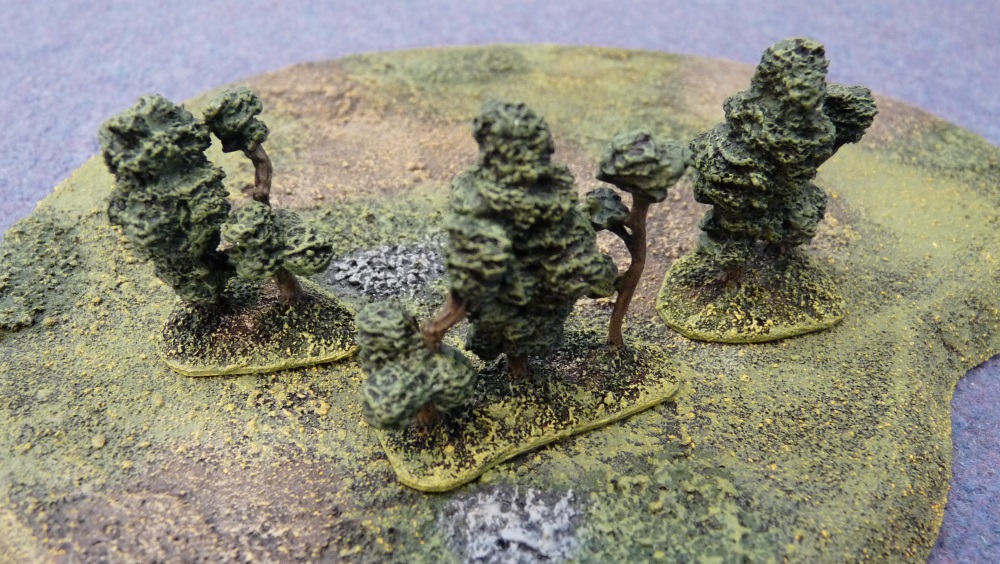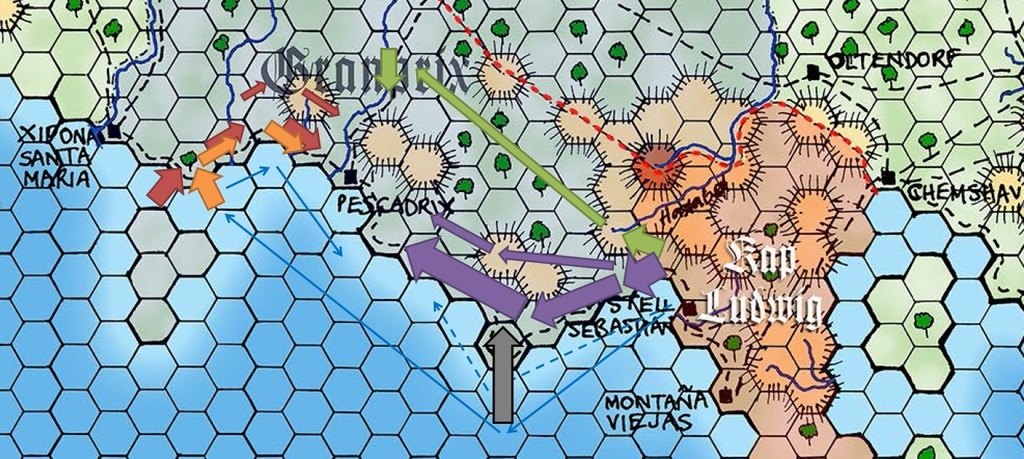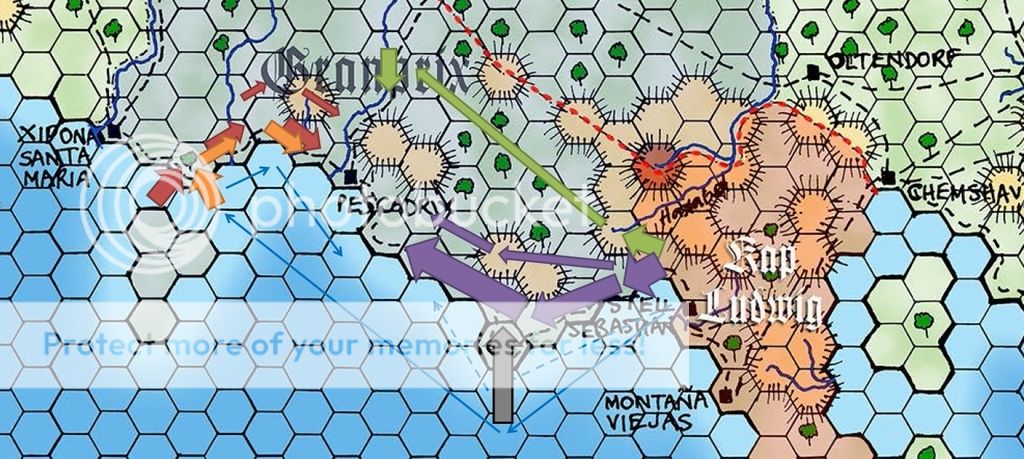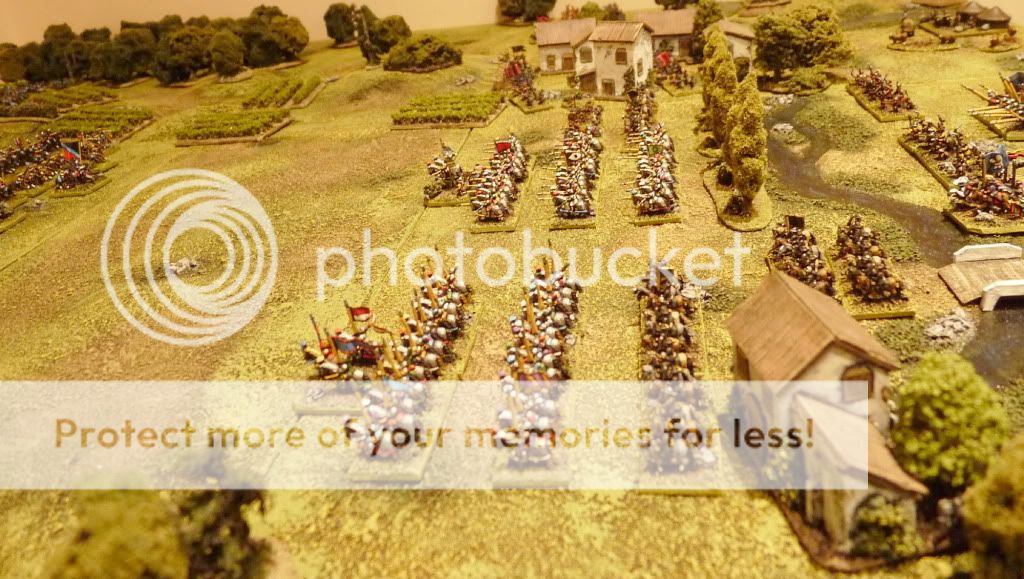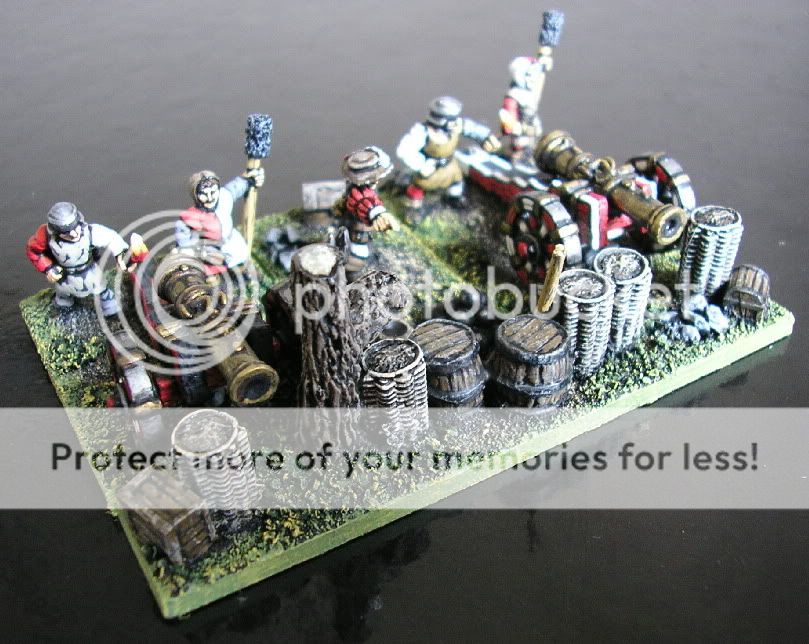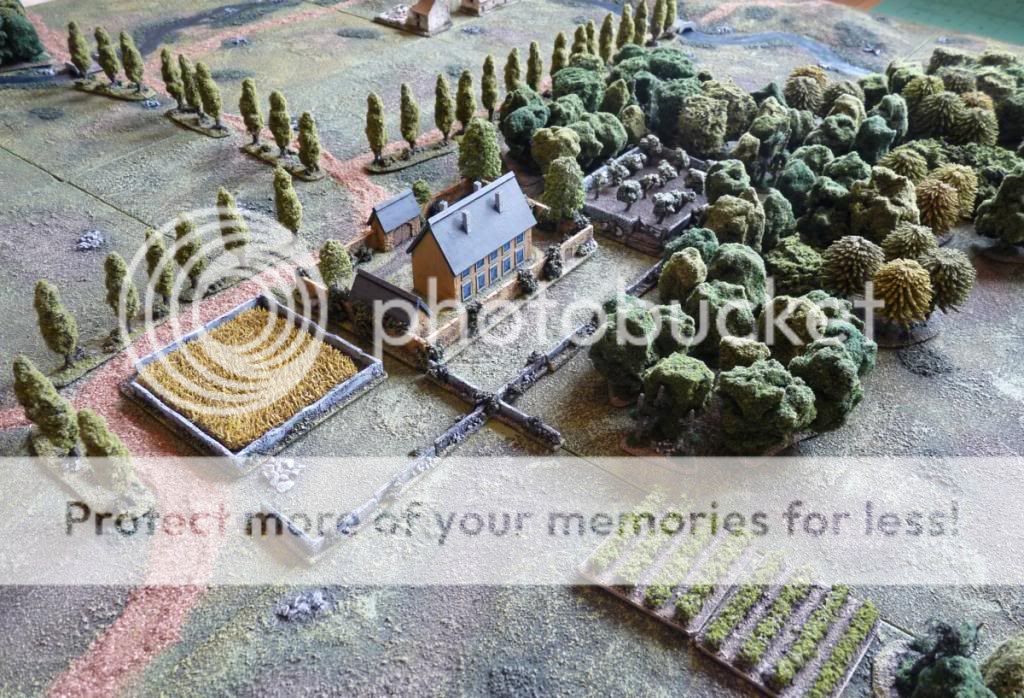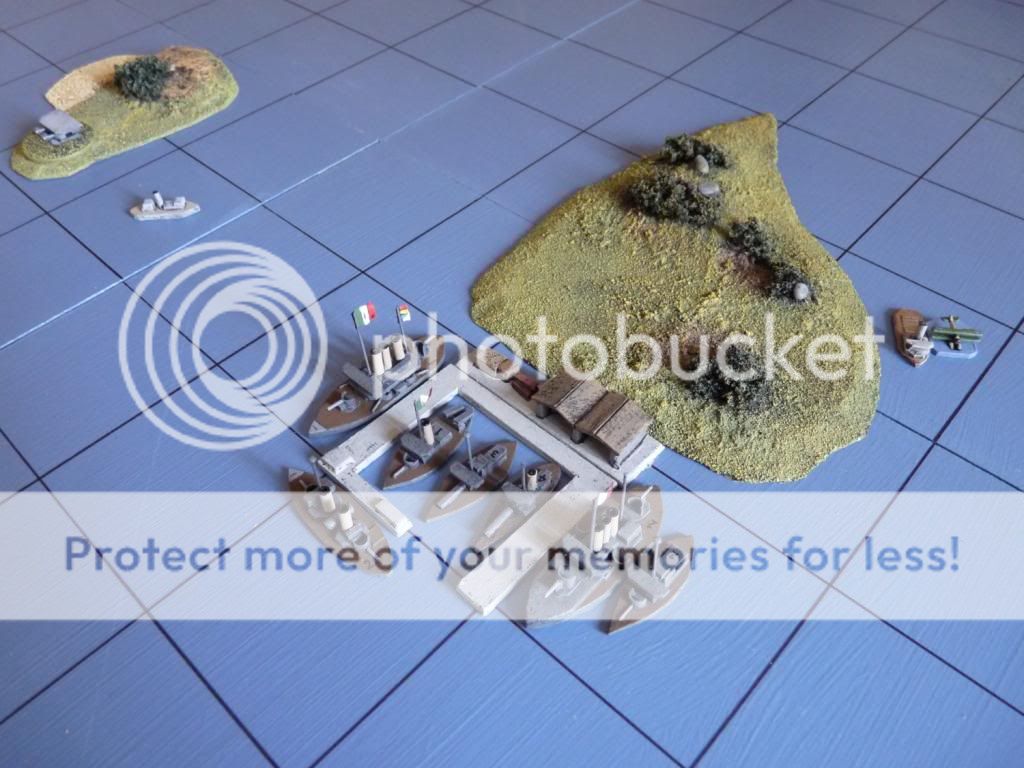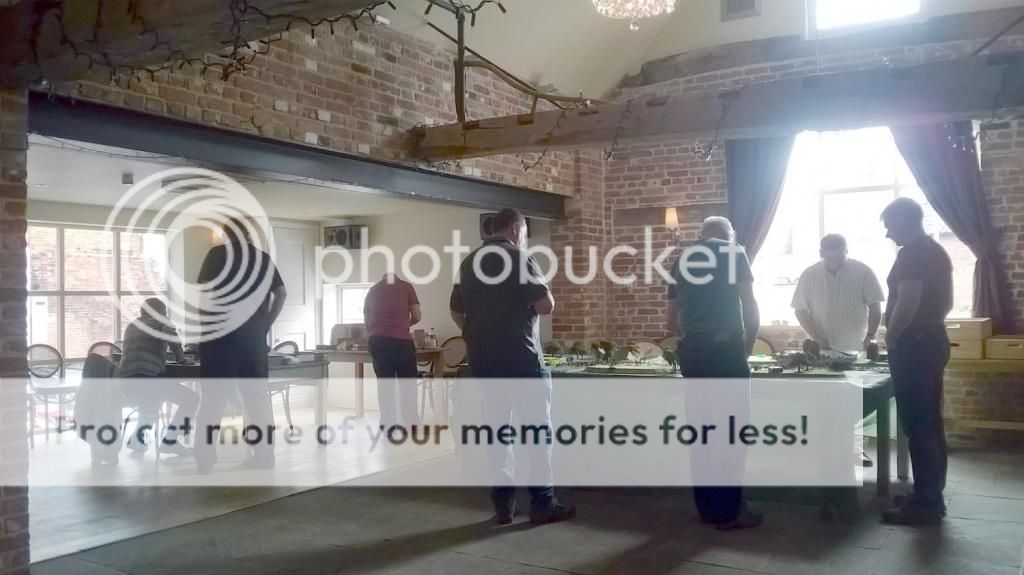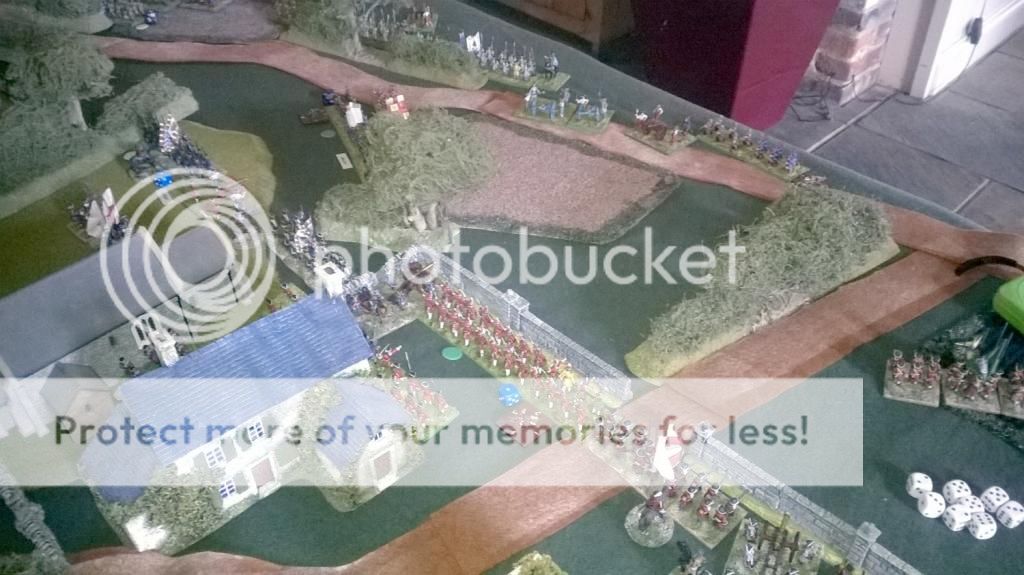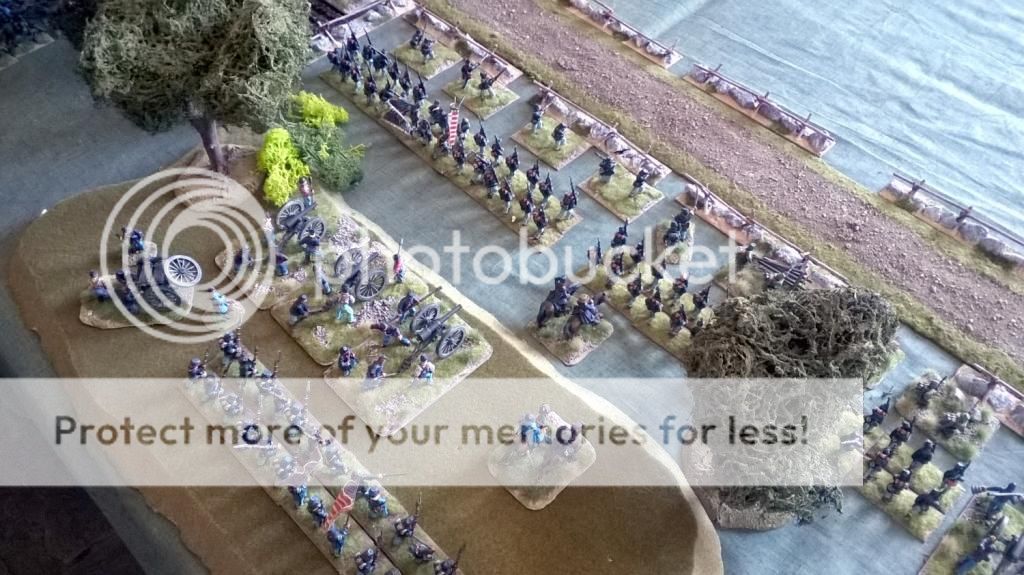I’m quite pleased to have made it to a hundred posts. You’re never sure with this sort of thing if you’ll keep it going or if it will just fizzle out. Anyway, it’s been fun so far so I’ll see if I can get to 200.
I didn’t have much new to post about but then, with Ayton 2015 fast approaching, I realised that I never did share my account of the Ayton 2014 campaign, other than with Henry Hyde. So, here is the official Medetian history, not too biased I hope, but naturally concentrating on my perspective of the pre-weekend planning and the on-table events themselves..
Ayton 2014 – Grenouisse Ascendant (but not for long..)
The Medetian Experience
The Plan
General Barolo, on finding himself appointed to the role of the Duke’s Chief of Staff, set about making the best of this dubious honour. Reining in some of the more impetuous allied commanders (Borscht and Darien
particularly) was the first priority so that a discussion could take place
about plans and timings. A conference was duly called and hosted by General Hauptzeige in the Governor’s Palace in Castell Sebastian. Numerous ideas were put forth, although geography, initial deployments and limited campaign time clearly suggested a two-pronged invasion, from the east by land, and from the west by sea.
With the Duke absent, the fact that the conference generated a reasonably
coherent plan, with everyone more or less in agreement, was a welcome surprise. That the various contingents’ own intentions (some of which were already being implemented!) were largely incorporated in the combined plan was no doubt the reason for such co-operation.
In short, the aggressive Borschtians, already occupying the
island off the Duchy’s southern coast, were to invade Granprix from west of the capital and its river lines. The Prunkland bridging column, kindly loaned by Hauptzeige, would go with them to assist in their advance east, and the doughty Wheyeydians would take ship to land in their support. Subject to what opposition they encountered, they would attempt to approach Pescadrix from the west and hopefully draw off a proportion of the defenders’ strength.
The eastern pincer would be a larger affair, with the main army departing Kap Ludwig and marching straight for Pescadrix, intending to smash through any opposition it encountered. The Medetians would lead on the
coast road, with light troops covering the hilly right flank where enemy advanced forces might be lurking. The rest of the main army would follow closely, consisting of the infantry and light troops of Darien, and the army of Prunkland, who would be last to depart. The Granprixian forces under the Duke would land by sea further along the coast and thereby link up with the main army, creating a combined (and hopefully unstoppable) force of over 2,000 figures.
The Darien cavalry, a mighty host in itself, would leave early and make its way north west through the hills and forests, aiming to cut the road north of Pescadrix and sever the enemy’s communications with Grenouisse. This force would then move south to close the net around the capital and hopefully re-join the main army for a final show-down close to the city. This part of the plan was altered mid-campaign as the cavalry column
would not have arrived in time, so instead the Darienite cavalry marched to the right of the main army and was close enough to be able to make a crucial contribution to both battles.
Substantial naval forces would carry out a number of operations, including escorting the Borschtians, Wheyeydians and Granprixians to their landing sites, scouting the enemy coast for activity and defences, covering the main army’s left flank from enemy naval intervention, and keeping an eye on things back at Castell Sebastian in case a coup de main was attempted by anyone (‘friend’ or foe). The weather was, as always, unpredictable but in the main these activities were carried out without too much mis-hap. Naval clashes took place, and a major battle is understood to have taken place late in the campaign, of which reports have not yet been received.
Many plots, intrigues and subterfuges were also planned during this period, and some were even implemented; a most interesting time it certainly was! General E Pickled, apparently dithering to and fro on the coast road, was shot and wounded in the arm despite his cavalry escort, leading to suggestions that his own side might have been responsible. The true motives of the Darienites and their Inquisition were suspected by many among the Duke’s allies, and efforts were made to observe their actions and restrict their access to the Kap once the army had departed. Prunkland in particular was sensitive to the risk of a coup in Castell Sebastian when the campaign was occupying our attention, and contingencies were put in place to defend against dastardly actions from disappearing cavalry columns, disguised infantry, mischievous feathered natives and sneaky naval forces.
Map of the
Granprixian Invasion Plan (click to enlarge)
Key:
Purple – Main Army; Medetia, Prunkland and Darien main force
Green – Darien Cavalry (although in the end they didn’t travel this far to the north)
Grey – Duke Zigor and his Granprixians
Red – Borscht
Orange – Wheyedia
The Campaign Itself
Somewhat amazingly, due to a combination of a reasonably straight forward plan, some curious enemy dispositions, a bit of luck, and a tremendous fighting spirit, the invasion proceeded very nearly as intended.
The enemy were unable to strongly oppose the main army and fell back before it, abandoning prepared positions without a fight. The army marched forward cautiously but in good spirits, eager to get at the enemy.
Granprixian guerilleros were encountered, providing intelligence, confirming that the enemy were out of position guarding against non-existent threats to the north west, and offering assistance in the coming fight. Both were welcome. Some naval skirmishes took place off the coast but, coming as they did after the key landings, without serious impact on the land campaign.
Finally, after a sedate march through the gentle Granprixian littoral, we found an enemy army that was ready to give battle.
First Battle
The enemy (the armies of Gateway and Altefritzenberg) took up a strong position anchored on the coast and village to their right (Gateway), with wooded hills and earthwork fortifications to their left (Altefritzenberg),
and with their combined cavalry in the plain between. Granprixian forces were assigned the extreme left of our attacking army, aiming to capture the village and had assault troops, led by their Grenadiers, literally advancing along the beach. The forces of Darien, Prunkland and Medetia occupied the centre and right of the army, with their units intermingled to give best advantage. A very strong cavalry force (largely from Darien) deployed to the right of the Granprixians, opposite the enemy cavalry. A mighty combined battery dominated the centre, and both close order and light infantry faced the hills and woods ready to advance and throw the enemy from them.
In short, the battle for the village was one of tough fighting and attrition, decided only when the enemy army retreated. Some local guerilleros also swept in by boat behind the Gateway line, intent on causing mischief and
confusion. Meanwhile the grand battery pulverised the enemy positions, and some of their cavalry, forcing the Altefritzenbergers to make the decision between being destroyed in place or advancing to their doom. They bravely chose the latter and, by coming to grips with our infantry down the slopes, actually protected themselves from much of the artillery’s fire. The skirmishes among the woods and ponds were prolonged, but a strong column of Medetian battalions, led by the Bravence Regiment, was pushing forward inexorably on the extreme right flank and when the enemy facing them finally broke, the end was in sight.
News of our large flanking movement to the north made by the rest of our
cavalry (some 130 figures) also hastened the enemy’s decision to give up the fight and save themselves for another day.
The true glory, however, was won on the plain where massed cavalry fought out a tremendous battle of charge and counter-charge. Splendid and in significant numbers though they were, the Gateway regiments, supported by those of Altefritzenberg, were no match for the seemingly endless hordes from Darien. Light cavalry soaked up the charge of the first Gateway wave, and the Darien Cuirassiers’ counter-attack was devastating. Three regiments fell to them in one turn, and in the confusion the legendary General E Pickled was cut down and ridden over while his cavalry fled. Rumours of his death were exaggerated and he has since retired to his estates. His cavalry Brigadier was captured in the same melee.
Although further Gateway battalions and batteries deployed to cover their cavalry’s rout, they could only serve as a rearguard while the rest of their battered army left the field to our victorious troops. Casualties had been mercifully light, and we needed only a day to re-group and resume our
march west to liberate Pescadrix.
Second Battle
After a day’s rest a short march took us to within sight of the ramparts of Pescadrix, our final objective. The army pivoted on its left flank, which hugged the coast, and swung around to the north of the city, penning the enemy back against it. Our naval scouts informed us that our Borschtian and Wheyeydian allies had fought an indecisive battle to the west two days before and had re-embarked on their ships to land again between the
enemy and the city. General Barolo sent them a message urging them to send a force to approach the city from the west and capture the main bridge over the river.
The enemy again entrenched and made use of what buildings they could in their defences. The Gateway forces deployed in front of the city while to their right were the Altefritzenbergers behind what earthworks they had prepared in time. The enemy right flank hinged on the customs house, which they’d fortified, and bent back to end literally in the surf. A buzz went through our army when it was revealed that the dastardly King Raoul himself was commanding the Grenouissian troops on that flank.
Fittingly, it was the army of Darien, whose priests had recently ex-communicated the King for his un-Christian ways (and, perhaps, for not granting Darien some Granprixian land in exchange for turning a blind eye) who opposed the Grenouissians. Once again massed cavalry would thunder across the plains.
In the centre, to Darien’s right, were the Prunklanders, ready to descend from the hills and capture the customs house in conjunction with their Darien allies. The right flank of our army was held by the forces of Medetia, with infantry and cavalry (including some regiments borrowed from the rest of the army) facing off against their counter-parts from the Gateway Alliance. The forces of Granprix itself had marched on a wider arc to the north and were due to come down the main road later in support of the Medetians.
Our battle plan was to pin the enemy in front of the city while rolling him up from his right flank, along the coast. Again, despite suffering setbacks and significant casualties, this plan was successfully executed, culminating in the capture of the despised King by Darien’s cavalry as his right flank collapsed.
Again a grand battery from Prunkland and Medetia covered the centre, smashing enemy units at will once it had won the fierce counter-battery duel with which the battle commenced. While the Darien troops swept across the plain, driving back the Grensouisse cavalry and assaulting the customs house, Prunkland supported them and held the centre. The Medetians engaged their Gateway foes and, while the light infantry fought each other to a standstill, the cavalry (led by Prunkland’s finest Cuirassiers) repeated the trouncing of the Gateway mounted arm that they suffered in the first battle. Three fine units were routed and a beautiful standard was captured. With things looking bleak for Gateway, their artillery, supported by the numerous heavy guns on the walls behind them, prevented a general collapse and took a heavy toll on our forces. The Medetian Weissach Grenz, El Z’Teeth Lancers and Rutowski Dragoons were each destroyed trying to come to grips with the Gateway batteries, sacrificing themselves to save the rest of the army from the murderous close range fire.
A cavalry thrust from the Wheyeydians on the other side of the river almost made it to the bridge, but a sudden sighting of Hunmanby’s landing on their southern flank drew them off before they could imperil the Gateway left flank and threaten the city. In their place came Granprixian fanatics and more guerilleros, braving artillery fire from the walls as they swept downstream in their boats. Despite losses they captured the bridge and landed beneath the walls themselves, opening fire on enemy troops there.
Final charges and last stands on all parts of the western battlefield saw dramatic and heroic actions on both sides, but when news of the King’s capture spread the heart went out of the enemy and the fighting began to
die down. Gateway and Medetia commanders signalled a tacit ceasefire and the brave defenders began to withdraw into the city, where their fate would no doubt be decided by diplomats eager to extract what advantages they could in the peace negotiations.
The word is that Raoul might be ransomed, but what was not in doubt was that Granprix, and in particular its finest jewel Pescadrix, would be returned to Duke Zigor. The army was victorious and, despite the sadness of its losses, the celebrations would reverberate for days!
So ends the account by General Barolo of the liberation of Granprix, this year of Our Lord, 1748.
Taking Goat Major’s advice I recently popped into Foundry’s new premises and shop at East Stoke near Newark. I needed a few figures (seriously, about a dozen) and hearing good things about their location and hospitality I thought I’d drop in on my way past.
I was welcomed and looked after with a coffee by Mick, who it turned out I knew through a forum we both frequent. Although I haven’t previously owned so much as a single Foundry figure, naturally I’d been aware of them over the years, and more recently heard about and seen the restoration of many of their old ranges. One thing you can be sure of with Foundry is plenty of choice – 13,000 packs I think(!?). The stocked racks go on for room after room and I suspect that if you haven’t done your research online beforehand you could easily be there all day. There are worse ways to lose track of time though, I guess 🙂
I just wanted some naval and other artillery crew types and their Crimean range was perfect. They’re not the cheapest, and these days might be a little smaller than most ’28s’, but I was very happy to pick up exactly what I needed.
So now I own some Foundry figs, and I’d better get going on them as the May event is approaching! I’ll post pics when they’re done.
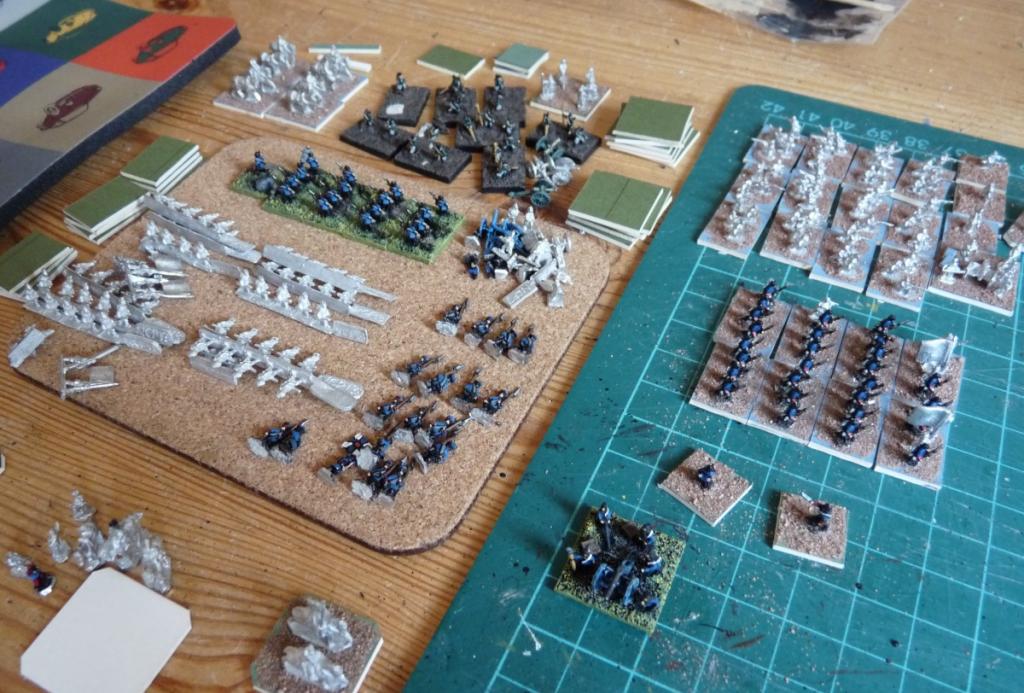
It’s been 6mm clipping and basing time here, with my Franco-Prussian War armies’ (modest) expansion now underway. I’ve changed the intended orders of battle several times, trying to work out the best balance of forces for the pencilled in multi-player game and for the collection itself going forward. Working with a number of spare figures I’ve devised a decent ’rounding out’ of my current forces which involves a minimum of new purchases and, most importantly, a minimum of painting. Laziness can be cost-effective!
The armies, French and Prussian/Bavarian, are based and organised for To the Last Gaiter Button by Realtime Wargames. I aim to have 2 corps per side, for a 4 player game. This will represent over 100,000 men in total and allow a fairly large battle to be played out.
Work in progress:
So that’s it for my 2014 wargaming, which I’ve enjoyed immensely. I’ve also got a lot out of maintaining the blog, and especially from all the comments people have made – they’ve been much appreciated. I need to get cracking again during January. I have a number of projects on the go at the moment, and a couple of deadlines to meet for games in the first part of the year. I need to set up and play a game too, so I’ll have a think about what this might be over a New Year’s Eve beer.
Happy New Year to everyone who’s dropped in this year, and I hope you do so again in 2015. Cheers!
It’s been a very quiet hobby month, as illustrated by the lack of posts recently. Work and other commitments have taken up most of my time and energy and I’ve struggled to get back to either the painting board or gaming table. Hopefully this weekend will see a turnaround.
I have managed to do some hobby thinking however, in place of actual activity! It’s getting to the time when people start laying out their plans, realistic or otherwise, for the coming year; painting, gaming, modelling, etc. I’ve contributed to one forum thread already and here’s an initial plan for where my priorities will (probably!) lie for 2015..
Games and get togethers:
- More home-and-away games with Goat Major, hopefully a continuing mix of Sharp Practice, 17th century skirmish and, with any luck, a return to Chain of Command (hint, hint)
- A group weekend with some forum pals, hosted between me and GM; more Sharp Practice and possibly a Corps-per-player FPW battle in 6mm
- A BIG battle at John Ray’s as part of his post-7YW campaign. I’ll be commanding a sumptuous horde of Austrians and allies against wily Old Fritz himself. Can’t wait!
- The ‘A Military Gentlemen’ forum group multi-player game at Partizan, which is going to be amazing and hopefully provide an excellent social weekend too
- The annual Ayton weekend in May; 19th century massed madness in the desert, followed by massed madness in the pub
- Just maybe, another autumn group gaming weekend if we manage to rally ourselves to plan one
- On the home front my plans are for:
- more Sharp Practice
- another 18th century solo battle
- some 15mm ancients and fantasy
- at least one 6mm Renaissance game, but hopefully a mini-campaign
- a return to the inter-war naval scene
All the above represents a lot of gaming, and an increase on this year’s achievements (which weren’t bad either). As far as I’m concerned that’s the way I want my hobby to be, so roll on 2015!
Painting ‘plan’ next..
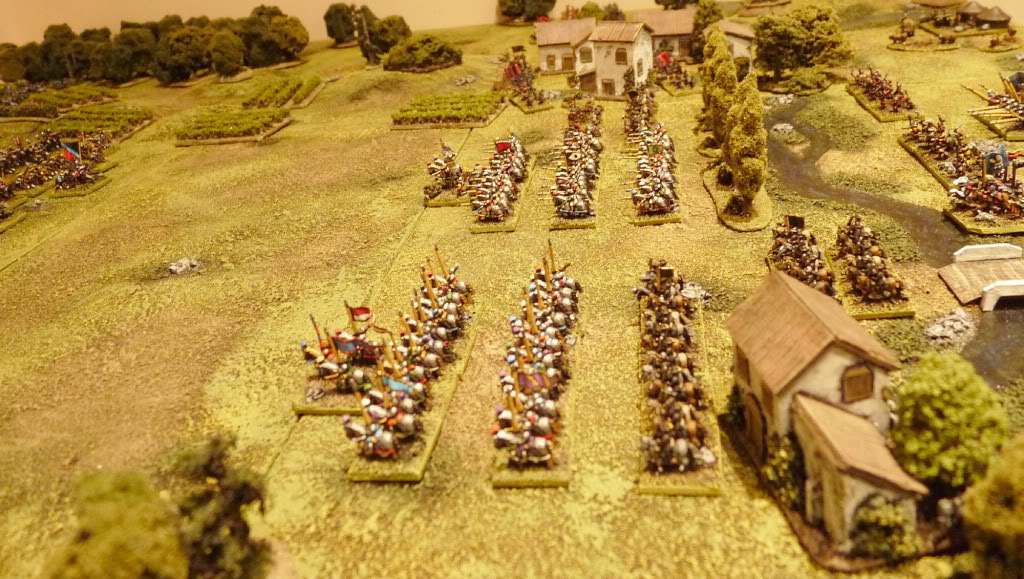
Today is the 1st anniversary of launching this blog, so happy birthday to The Medetian Wars. It’s been fun for me so far and I’ve really appreciated everyone who’s popped in to have a look and I’ve been especially grateful for all the positive, supportive comments. There have been over 6,000 page hits, which I think isn’t too bad for a new blog in a quiet corner of the hobby.
Although there has been the odd dip where real life has left little time for painting, playing or blogging, I’ve generally kept up a reasonable momentum of posts; about 6 a month. I think the blog has helped me keep projects moving to some extent so it’s been positive from that point of view too. Army of the Month petered out but shouldn’t have done really. I’ll resurrect it soon – once I can get some terrain out for a photoshoot!
On to year 2 then, and hopefully I’ll get some more gaming in to post about soon (doesn’t everyone say that?)…Anyway, it’s an opportunity for a few celebratory pics I haven’t posted before:
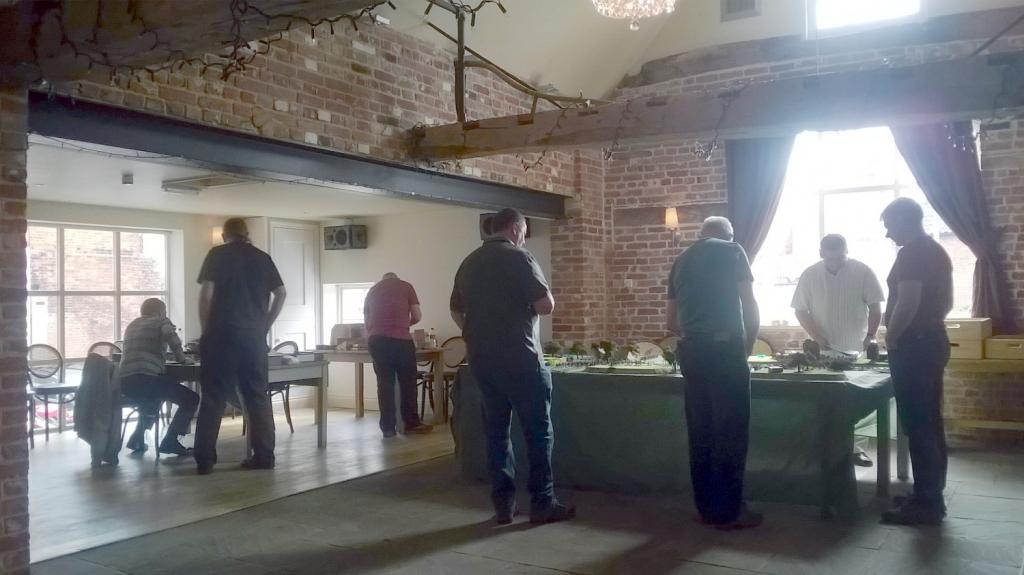
This weekend saw a get together of a group of wargamers from up and down the length of England (unfortunately our Scottish contingent couldn’t make it). We congregated on Friday evening in the Suffolk town of Framlingham, where our local host Tim had made the arrangement for us to have an excellent couple of days of gaming, socialising and recovering from hangovers.
It was a fair old way to go, especially for those coming from the North East, but everyone agreed it was more than worth it. Great company and top-notch games throughout, and lots of laughter and banter to go with it.
We used the very nice function room at The Crown, a lovely hotel/inn where some of us were staying, which gave us plenty of room and facilities to spread out in. Despite this pic, the lighting was a bit dim when the sun wasn’t shining (ie. most of Saturday) so I didn’t get many decent photos on my phone.
Several people had offered to put on games (there were several rounds of voting(!) over a year ago), providing the figures, rules and scenery for others to play. These included Peeler’s Leipzig DBN taster (for Simon, who seemed to enjoy it immensely), Essex Boy and GaryP’s 20mm Marlburian game (which Andy and I joined), and the main event – Tim’s awesome ACW collection in a full-on 2 day clash which started on Saturday and which we all joined on Sunday.
The WSS game was great fun, and it was a pleasure to play with Iain and Gary’s superb collections. The rules used were Rank and File from Crusader, and they gave a quick realistic game with simple, easy to learn, mechanisms. We played at least 12 full turns which says a lot for how easy the rules are to pick up. Everyone agreed that it looked and fought out as they imagined a Malburian battle would, and we had some very exciting moments as both sides had triumphs and reverses.
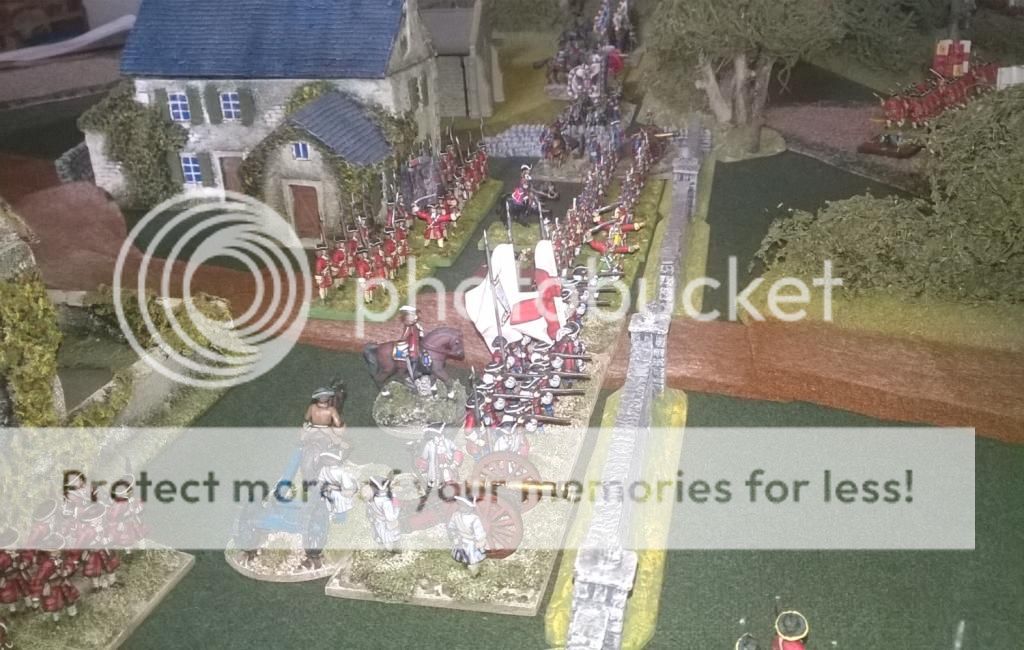
As allied commander I had the dubious benefit of Iain’s dice rolling assistance (he was also the scenario designer and umpire) but fortunately the English, Dutch and Danes fought tenaciously among the hedgerows and successfully held the right and centre against the French infantry. It didn’t go so well on the left, however, where the cavalry fought it out in the open fields. Here the enemy gradually got the better of the allied squadrons, helped by an infantry brigade which came up and held the farm in the middle of the melee. Their volleys emptied a good few saddles and by the end (which was deemed to be dusk) our flank had collapsed.
We all surveyed the battlefield and agreed it to be a strategic success for the French, as the allies would eventually have to retreat down the only road they remained in control of, but a tactical draw, as 2/3 of the table remained in allied hands as night fell. A really enjoyable game all-round, with friendly and generous opponents in Andy and Gary, and lots of thanks to Iain for the effort he put into planning and running the game.
Then it was off to the bar for a well-earned beverage or two and the usual debate about basing, followed by an excellent curry in a nearby restaurant and more beers in Tim’s local.
On Sunday we all re-assembled (some more slowly than others..) for the now-expanded ACW game. Tim, Phil, Dave and Tim W had fought the opening moves of this encounter battle (Coinville I think) on day 1 and developed the battlelines that the rest of us joined for day 2. I was on the Union side (which I think I’ve been on every time I’ve played this period, but which is fine by me) and I was involved in trying to defend the centre and right against an outflanking Reb attack, while waiting for our reserve division to arrive.
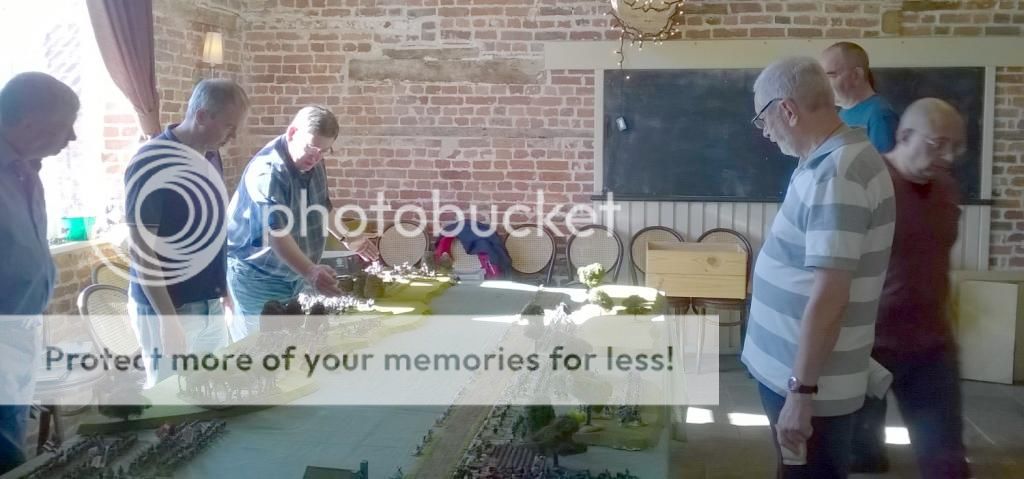
There was lots of artillery fire initially, and then the infantry got to grips and casualties mounted. The whole time JEB Stuart was dashing round our right flank and things were a bit nervous as we waited for the outcome of the Union CinC’s rolls to see where the reserve would appear. Naturally Iain’s dice ensured it would be at the other end of the table, and that sounded the death knell for the North! Unfortunately I had to leave before the final turns were played, but it was a delight to see these armies on the table again and to be involved in such a great looking game.
Some of my division, all gorgeous figures from Tim Hall’s collection:
All in all, everything went even better than expected and we’re looking forward to the next opportunity to get together again for another one. Big thanks go to Tim for all the planning/arranging, and to everyone for their excellent company!
I have an evening to myself coming up this Friday and rather than waste it watching TV or an old film, I reckon it’s too good an opportunity to miss to have a solo game. Now I just need to decide what to play..
Without giving it much thought yet, my initial ideas include:
Something in 15mm (which I’ve not trotted out for a while), maybe one of:
- Caesar at the Battle of the Sambre, for which I’ve got a scenario written up and ready to go
- A 2nd Punic War clash
- Rampaging Goths and Huns against the late Roman Empire
- Or, a fantasy game – Dwarves vs Orcs as I haven’t really given the Dwarves a proper run out since painting enough for a decent game
Alternatively I could stick with 28s, and perhaps give the 18th century another go. I fancy re-fighting John Ray’s scenario ‘Attack on the Garrison at Tilsit’ which looks like a very interesting, compact encounter.
I’ll mull things over for a couple of days and probably decide on Friday. It’s too easy to view getting all the terrain, scenery and figures out just for a solo game as too much bother, but if I don’t make the effort from time to time, what’s the point? It’s always rewarding and I always feel it’s time well spent – so roll on Friday!
I’ll be sure to post, whatever the game ends up being.

